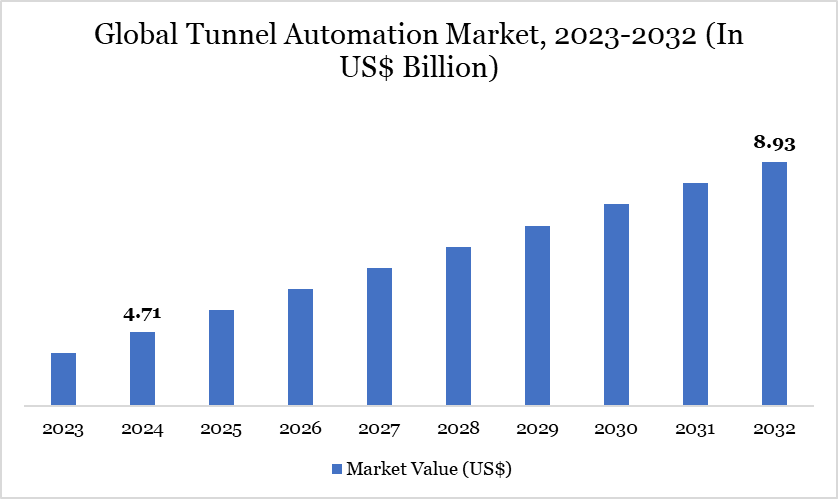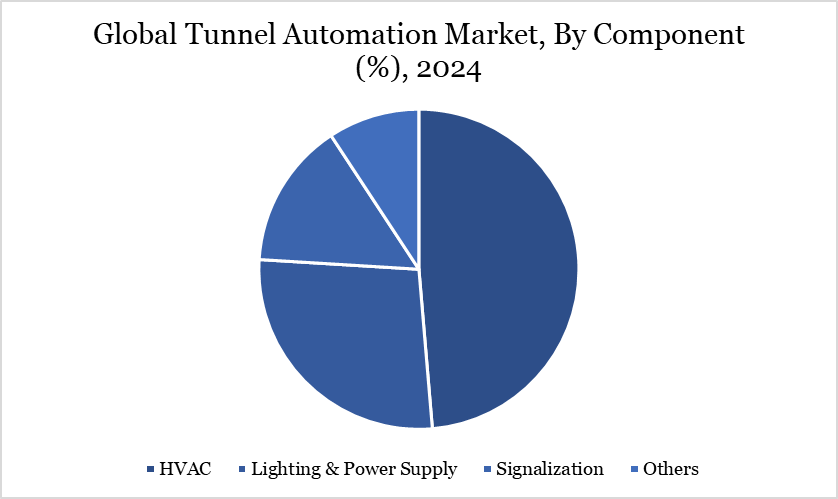Overview
Global tunnel automation market reached US$ 4.71 billion in 2024 and is expected to reach US$ 8.93 billion by 2032, growing with a CAGR of 8.32% during the forecast period 2025-2032.
The global tunnel automation market is rapidly expanding, driven primarily by rising infrastructure demands, urbanization and the need for improved tunnel safety and operating efficiency. The expansion of this market is being driven by strict safety requirements enacted by organizations such as the European Union and the US Department of Transportation, which require thorough safety and operating standards in tunnels.

Tunnel automation systems are evolving to enable real-time monitoring, decrease operating hazards and require less human interaction as IoT, AI and smart sensors advance. Many large tunnel projects are now in various phases of development or planning. A significant example is the Turin-Lyon base tunnel, when in April 2022, Webuild and its Swiss subsidiary CSC Costruzioni successfully completed the test run of an innovative robot named as AXEL.
Tunnel Automation Market Trend
The growing use of automation technology is a major trend in the worldwide tunnel automation industry. Cutting-edge technology such as smart sensors, AI-powered surveillance and IoT-enabled systems are changing tunnel monitoring and maintenance. Automated technologies, such as lighting controls and fire detection systems, contribute to effective tunnel operations by decreasing human intervention and the danger of accidents.
With global urbanization accelerating, particularly in emerging economies, there is an increasing demand for efficient traffic flow and connectivity between cities, which is driving tunnel building. According to the United Nations in 2018, 55% of the world's population resides in urban areas and this figure is predicted to rise to 68% by 2050, making tunnel infrastructure a vital component of urban growth plans.
Market Scope
| Metrics | Details |
| By Offering | Hardware, Software, Services |
| By Component | HVAC, Lighting & Power Supply, Signalization, Others |
| By Tunnel Type | Railways, Highway and Roadway Tunnels |
| By Region | North America, South America, Europe, Asia-Pacific, Middle East and Africa |
| Report Insights Covered | Competitive Landscape Analysis, Company Profile Analysis, Market Size, Share, Growth |
Dynamic
Rising Safety Concerns
Tunnel automation is being driven primarily by growing concerns about tunnel safety and the necessity for real-time monitoring systems to address emergency situations. Tunnels involve unique safety risks, such as accidents, fires and ventilation issues, hence governments and regulatory agencies have adopted stringent safety precautions. For example, the European Union's Tunnel Safety Directive has set strict standards for safety equipment and emergency readiness, pushing the implementation of automated tunnel management systems.
Furthermore, market expansion is being driven by global government support for infrastructure spending and legislation. In the US, the Department of Transportation has allocated significant resources to improving roadway and tunnel infrastructure, emphasizing the significance of leveraging smart technologies to improve safety and traffic control. Furthermore, tunnel projects supported under the China Urban-Rural Development Plan include automation technology to ensure efficient operations in the country's developing tunnel network.
Workforce Shortage and Regulatory Concerns
Despite the positive outlook, workforce shortages and stringent regulatory hurdles pose significant challenges to the tunnel automation market. Project delays are occurring in developing countries due to a lack of skilled workers available to install and maintain complex automated systems. The International Labour Organization (ILO) has highlighted the global shortage of skilled labor in construction and infrastructure projects, which could slow down the adoption of tunnel automation technologies.
In addition, the regulatory landscape for tunnel automation is complex, with each country having its own set of standards and certifications for safety and environmental impact. In the European Union, compliance with the Tunnel Safety Directive is mandatory for all new tunnel constructions, which can increase the time and cost of deploying automated systems. Similarly, countries with stringent environmental laws may impose additional regulations on energy consumption and emissions, impacting the deployment of automated technologies.
Segment Analysis
The global tunnel automation market is segmented based on offering, component, tunnel type and region.

Demand for Automated Lighting Systems due to Heavy Traffic Flow Drives Lighting & Power Supply Segment Growth
The lighting and surveillance systems are in high demand. Automated lighting & power supply, which manages traffic flow and exterior light conditions, improves visibility and safety within tunnels. Smart lighting solutions are predicted to reduce energy usage in tunnels by 25%, improving overall operational efficiency.
Surveillance systems, which feature AI-powered video analytics and real-time monitoring, are also in great demand since they allow for quick reaction to emergencies and traffic issues. Another important aspect of tunnel automation is ventilation systems, which are responsible for maintaining air quality and preventing the buildup of dangerous gasses. According to the European Environment Agency, poor air quality in tunnels can pose health concerns to both drivers and maintenance workers, emphasizing the significance of automatic ventilation systems.
Geographical Penetration
Rising Government Initiatives in Asia-Pacific
Asia-Pacific is leading the tunnel automation market's expansion, owing to growing urbanization, government initiatives for smart cities and large-scale infrastructure projects. China is leading the way, with the National Development and Reform Commission (NDRC) investing significant funds for tunnel development as part of the Belt and Road Initiative.
Japan and India are also investing heavily in tunnel infrastructure, with India's National Infrastructure Pipeline (NIP) highlighting tunnel development as a vital area of investment to increase road and rail connections. For example, India is building the world's longest railway tunnels to connect Indore and Mumbai. The 49-kilometer tunnel will not only improve transportation but also provide access to the picturesque Patalpani waterfall. Such activities increase the demand for tunnel automation in the country.
The region's fast population expansion and urbanization are driving up the demand for safe and efficient tunnel systems. The Asian Development Bank estimates that Asia-Pacific’s infrastructure spending needs for 2016-2030 will rise from US$ 22.6 trillion to US$ 26.2 trillion once climate change measures are incorporated, with a significant portion of this allocated to transport infrastructure, including tunnels.
Sustainability Analysis
The global tunnel automation market is becoming more aligned with sustainability goals, fueled by the need to reduce energy consumption and carbon emissions in tunnel infrastructure projects. Governments and environmental organizations, such as the International Energy Agency (IEA) and the United Nations Environment Programme (UNEP), are highlighting the necessity of energy efficiency in infrastructure projects like tunnel construction and operation. Automated solutions such as smart lighting, ventilation and traffic control in tunnels are playing a significant role in saving energy through effective resource usage and waste reduction.
For example, automated ventilation systems regulate air quality by monitoring current traffic and environmental conditions, ensuring that energy is only used when necessary. This reduces tunnel operational costs and environmental impact, increasing long-term sustainability. According to the European Commission's regulation on energy efficiency, sustainable practices in infrastructure, particularly tunnel systems, are expected to dramatically cut energy consumption.
Competitive Landscape

The major global players in the market include Siemens AG, Johnson Controls, ABB, Honeywell International Inc., Philips Lighting, Eaton, Osram, Delta Electronics, Inc., SAGE Automation and Gsystems.
Key Developments
In June 2024, ABB India, in cooperation with Witt India, provided cutting-edge tunnel ventilation systems that set new standards for tunnel ventilation safety and efficiency. ABB's unique smoke extraction motors, which can resist severe temperatures during emergencies, improve safety and reliability in vital road tunnels throughout India.
In May 2024, Siemens, a prominent global technology corporation, has developed a groundbreaking invention for managing multiple hardware control points within plants. The Siemens Simatic Automation Workstation allows manufacturers to replace traditional hardware components, such as PLCs (Programmable Logic Controllers), HMIs (Human-Machine Interfaces) and edge devices, with a single, software-based solution. It provides increased control and monitoring capabilities for large tunnel infrastructure projects.
Why Choose DataM?
Data-Driven Insights: Dive into detailed analyses with granular insights such as pricing, market shares and value chain evaluations, enriched by interviews with industry leaders and disruptors.
Post-Purchase Support and Expert Analyst Consultations: As a valued client, gain direct access to our expert analysts for personalized advice and strategic guidance, tailored to your specific needs and challenges.
White Papers and Case Studies: Benefit quarterly from our in-depth studies related to your purchased titles, tailored to refine your operational and marketing strategies for maximum impact.
Annual Updates on Purchased Reports: As an existing customer, enjoy the privilege of annual updates to your reports, ensuring you stay abreast of the latest market insights and technological advancements. Terms and conditions apply.
Specialized Focus on Emerging Markets: DataM differentiates itself by delivering in-depth, specialized insights specifically for emerging markets, rather than offering generalized geographic overviews. This approach equips our clients with a nuanced understanding and actionable intelligence that are essential for navigating and succeeding in high-growth regions.
Value of DataM Reports: Our reports offer specialized insights tailored to the latest trends and specific business inquiries. This personalized approach provides a deeper, strategic perspective, ensuring you receive the precise information necessary to make informed decisions. These insights complement and go beyond what is typically available in generic databases.
Target Audience 2024
Manufacturers/ Buyers
Industry Investors/Investment Bankers
Research Professionals
Emerging Companies


